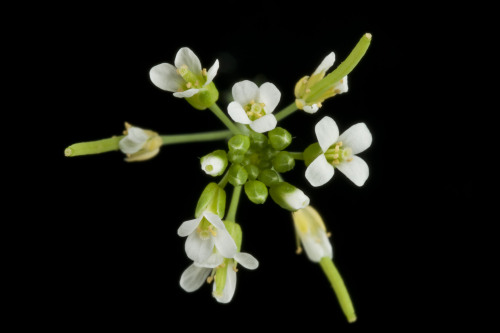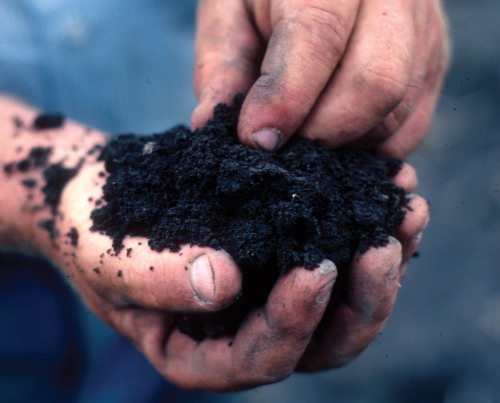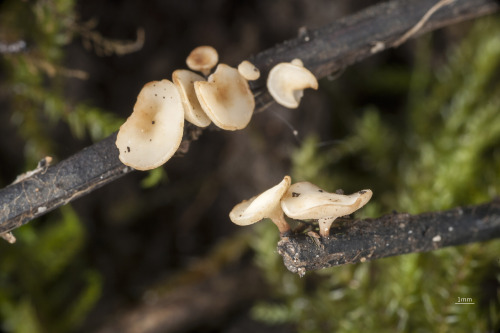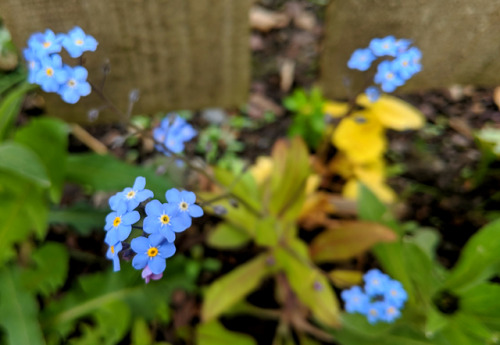#plant science
Scientists solve plant sperm puzzle
Chloroplasts are where plant cells perform photosynthesis and wheat, like many other plants, inherits chloroplasts only from the mother through small precursors called plastids.
But how this happened was unknown – why didn’t the male’s chloroplast DNA travel with the rest in sperm?
By tagging plastids in wheat with a protein that glowed green scientists at Rothamsted Research and the University of Manchester could watch them in developing pollen grains. They saw for the first time that plastids are degraded in sperm cells just before fertilisation, meaning only plastids from the mother plant are inherited by the offspring.
In the image above the top line shows the protein attached to the plastids in wheat pollen, in the bottom row it is untargeted.
The finding could be used to help breed better strains of wheat, one of the world’s most important and valuable crops.
Image: Huw Jones, Rothamsted Research
Post link
Zombie plants
Scientists have discovered how a bacterial parasite turns plants into the living dead.
The bacteria is able to manipulate the way plants grow, causing infected plants to transform their flowers into leaf tissue.
In doing so, the plants are sacrificing their reproductive success and becoming sterile – dead to the future and destined to only benefit the survival of the bacteria parasite (healthy plant seen in the top image and an infected plant can be seen in the middle image).
The parasitic bacterium produces a protein that tricks the plant into transforming its flowers into leaf-like material. This transformation makes the plant more attractive to leafhoppers for settlement - the bacterium’s next victim and host to be (see leafhopper in bottom image).
Once an enticed leafhopper eats the infected zombie plant, the bacteria then catches a ride in their saliva on to the next plant they hop on to – starting the cycle all over again.
This research comes from the labs of Professor Hogenhout at John Innes Centre, and Professors Angenent and Immink at Wageningen University.
Images: John Innes Centre
Post link
More crop per drop: growing food with less water
Partial root drying allows some crops – everything from tomatoes to grapes – to be grown using up to half as much water, while producing about the same amount of fruit.
Of all the fresh water people use, more than two thirds is used for agriculture. Increasingly, water is in short supply in many important food-producing regions of the world and, as pressure on water use rises, so can the price of food. This is particularly important in drought-prone countries like China.
Partial root drying, developed by Professor Bill Davies and his team at the University of Lancaster, works like this: When one side of a plant’s roots are starved of water, signals are sent to the leaves to slow their growth, reducing water use. These signals also tell the plant to close leaf pores called stomata, reducing water loss.
Although the growth rate of the leaves declines, because the other side of the plant is being watered, it doesn’t wilt and carries on producing fruit. Alternating which side of the plant receives water prevents roots from dying in very dry soil.
In the area around Wuwei City in China, between 30,000 and 40,000 Olympic swimming pools’ worth of irrigation water is being saved each year by using this and other similar techniques.
Images:BlueRidgeKitties,NRCS Soil Health,allpossible.org.uk
Post link
How plants put up a fight
They might look weedy but plants know a thing or two about defence. When confronted by harmful bacteria, plants use sophisticated pattern recognition ‘software’ to seek and destroy. However some bacteria can bypass the system, weakening defences by releasing molecules known as ‘effectors’.
Professor Murray Grantand team from the University of Exeter have discovered that chloroplasts, the powerhouse behind photosynthesis, play an key role in plant defence. The team found that effectors produced by pesky pathogens damage chloroplasts and lead to molecular changes that allow bacteria to take hold. Pre-treating plants with molecules from microbes protect chloroplasts from bacterial effectors and the damage they cause.
Engineering intervention strategies to protect chloroplasts could help provide resistance for plants, and vital food crops at risk from infection.
Image credit: Professor Grant Murray, University of Exeter
In the images above, red coloured leaves have healthy chloroplasts. Images that are yellow, through to green, to blue represent leaves with increasingly damaged chloroplasts.
Post link
Breakthrough on ash dieback
UK scientists have identified the country’s first ash tree that shows tolerance to ash dieback.
Ash dieback is spreading throughout the UK and in one woodland in Norfolk, a great number of trees are infected.
The team compared the genetics of trees with different levels of tolerance to ash dieback disease. From there, they developed three genetic markers which enabled them to predict whether or not a tree is likely to be tolerant to the disease. One tree named Betty, they discovered, was predicted to show strong tolerance.
The findings raise the possibility of using selective breeding to develop strains of trees that are tolerant to the disease to help safeguard our forests.
Images: Close-up infected ash petioles (leaf stems) - Copyright: John Innes Centre
Post link
All the Plant Shows, part two
All the Plant Shows, part two
Plant podcasts are big these days, or at least that’s what it seems, which is why this has turned into a multi-part post (see part one). While in the process of compiling a list of plant podcasts that I’ve become aware of, I keep stumbling onto more. Which is great! It’s a trend that I hope continues. As it continues, I will go on compiling them here until we have ourselves a list of All the…


Podcasts are among the most accessible and powerful mediums through which we can tell and hear the stories of plants. The popularity of podcasts is evidence that if we want to share our love of plants with the world and get others to love them too, we have to be using podcasts to do it. They are essential tools in the communication of plant science and, when used effectively, they may even help…
Randomly Selected Botanical Terms: Prickles
Randomly Selected Botanical Terms: Prickles
Let’s start by getting something out of the way: roses have prickles, not thorns. However, just like peanuts aren’t actually nuts and tomatoes are actually fruits, our colloquial terms for things don’t always match up with botanical terminology. This doesn’t mean that we should be pedants about things and go spoiling a friendly dinner party with our “well, actually…” corrections. If you hear…

Podcast Review: Plants and Pipettes

Gardening was my first introduction to plants. I enjoyed growing plants so much that I decided to study them. Or rather, I studied the growing of them,i.e.horticulture. During my studies, I became increasingly interested in botany, a vast scientific field that investigates all things plant related, from their evolutionary history to their cellular biology to their interactions with other…
So I haven’t posted much to tumblr lately because I’ve been super busy doing my MSc research project on these little fellas - Sitka spruce (Picea sitchensis) tree somatic embryos. I’m trying to see how they respond to being frozen in liquid nitrogen. When I was told I’d be working with liquid nitrogen I couldn’t help but be a tad excited!
Post link
True Blue Flowers at the allotment /part 1
You know I love blue flowers, but you might have not noticed how uncommon ‘true blue’ flowers actually are in nature. In the animal world, the presence of this colour is often just an optical effect caused by how light is absorbed and refracts in particular structures. In plants, however, different shades of real blue are the result of chemical changes that alter the red and purple anthocyanin pigments present in a large variety of species.
This is not a common process and it has proven to be particularly challenging to replicate artificially. If you like technical details, here you can read about how the first -passably- blue Chrysanthemum was created.
Some plant families though, seem to have mastered this prodigious alchemical feat and produced a good variety of sky-coloured species, which have been further diversified artificially in as many cultivars. Probably the most prominent of these families, the Boraginaceae has gifted us with some of the most common blue wildlfowers you could encounter in temperate areas, and plenty of garden ornamental plants.
In the photos above you can see members of this family currently blooming at my veg plot and, if you look closely, you can see how the flower buds on all these plants look pink, but the pigments start changing as they open to reveal different shades of true blue:
-Borago officinalis, borage: annual herbaceous
-Lithodora diffusa ‘Blue Star’&‘Heavenly Blue’: evergreen subshrubs
-Brunnera macrophylla ‘Jack Frost’, Siberian bugloss: deciduous herbaceous perennial
-Myosotis scorpioides, water forget-me-not: herbaceous perennial
-Myosotis arvensis, field forget-me-not: herbaceous annual or short-lived perennial
Now check back in a few years please, I’m on my way to holding the national collection of Boraginaceae and the largest variety of blue flowers in one garden ;)
Post link



















